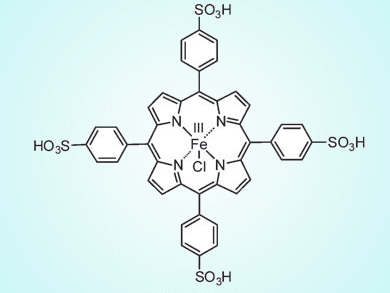Harald Gröger and co-workers, University of Erlangen-Nürnberg, Germany, have reported a synthetic, water soluble iron(III) porphyrin that can act as an artificial, biomimetic water producing NAD(P)H oxidase. They used a iron(III) complex containing the water-soluble, fourfold meso-tetrakis(4-sulfonatophenyl)porphyrin (TSPP) as a ligand. This activated and reduced molecular oxygen as well as acting as an artificial biomimetic NAD(P)H oxidase.
Additional biotransformations were carried out with monosaccharides: D-mannonic acid and D-xylonic acid were obtained with good to excellent conversions of 73 % and greater than 95 %, respectively. The alcohol dehydrogenase catalyzed oxidation of cyclooctanol into the corresponding ketone also proceeded with over 95 % conversion.
This is the first use of a synthetic metalloporphyrin as a catalyst for the activation and reduction of molecular oxygen into water by means of a natural cofactor in aqueous solution.

Image: (c) Wiley-VCH
- Iron Catalysis for In Situ Regeneration of Oxidized Cofactors by Activation and Reduction of Molecular Oxygen: A Synthetic Metalloporphyrin as a Biomimetic NAD(P)H Oxidase
H. Maid, P. Böhm, S. M. Huber, W. Bauer, W. Hummel, N. Jux, H. Gröger
Angew. Chem. Int. Ed. 2011.
DOI: 10.1002/anie.201004101




